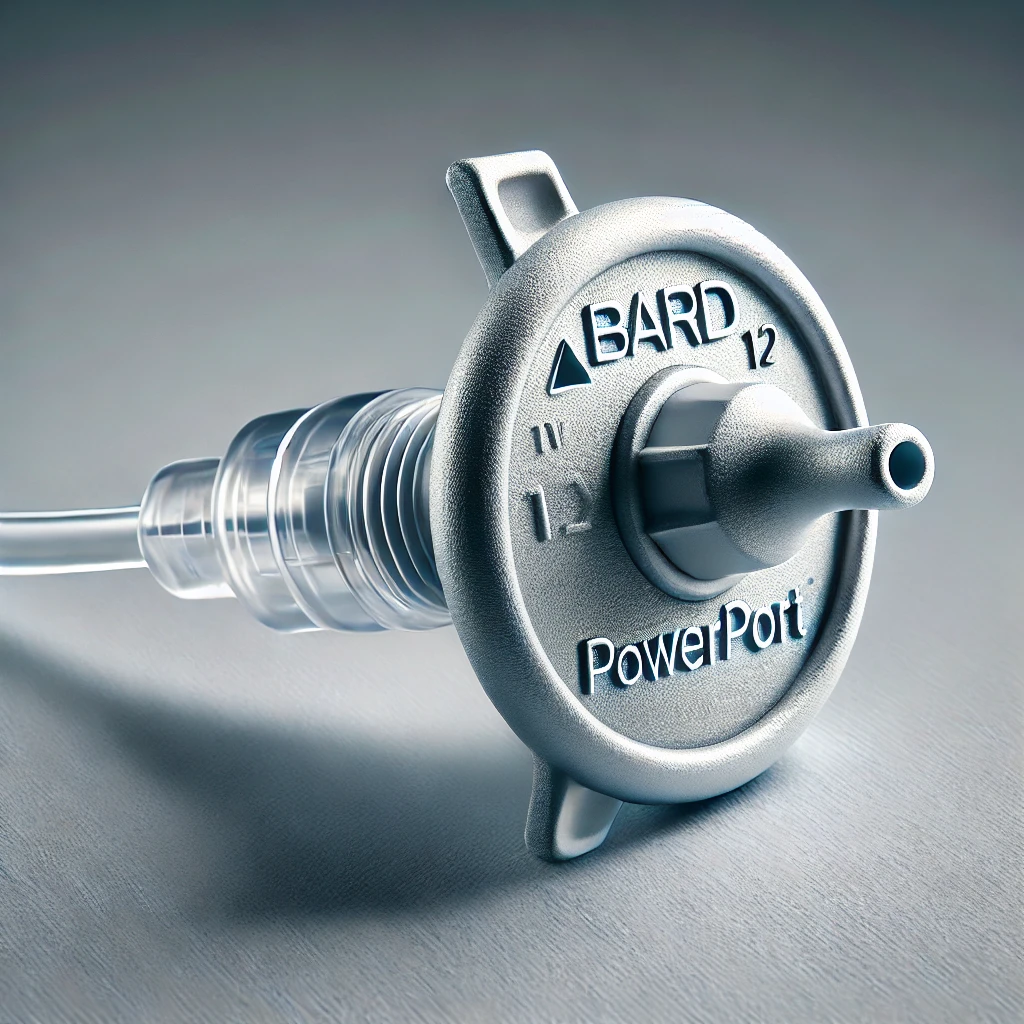Those who claim that the powerPort device caused significant injuries are filing a sworn lawsuit against Bard PowerPorts. Those lawsuits argue Bard Access Systems, which is incorporated by Becton Dickinson and Company, did not warn patients about potential health problems involving them. The pending case carries the status of multiple districts pending litigation in the state. The suit continues in court in this case.
Bard PowerPort devices, used for delivering medication and drawing blood, have recently become the center of a growing number of lawsuits. Patients from various parts of the United States have reported significant complications related to these devices, sparking widespread concern. The primary issues involve device fracture, infection, and migration, leading to severe health consequences. Understanding these lawsuits is crucial for those affected and provides insight into the legal landscape surrounding medical device litigation.
Mass Tort America is dedicated to helping those who have suffered due to defective medical devices like the Bard PowerPort. Our team is equipped to handle complex litigation and can offer guidance through every step of the legal process. With our nationwide reach and specialized concierge team, we aim to provide comprehensive support to clients across the country. If you or a loved one has been affected by Bard PowerPort complications, we may be able to help you seek justice and compensation.
Understanding Bard PowerPort Complications
So, what is a Bard PowerPort? A medical device called a port is implanted into a patient’s body to provide repeated access to patient’s vascular system. Ports can be used for administering intravenous nutrition, medications such as chemotherapy, or for regularly withdrawing blood.
Bard PowerPort is designed to facilitate long-term intravenous therapy, often used for chemotherapy, nutrition, and blood transfusions. However, many users have experienced severe issues, primarily due to device malfunction. One of the most alarming problems is the fracturing of the catheter, which can lead to pieces of the device migrating through the bloodstream, potentially causing life-threatening conditions such as pulmonary embolism or cardiac arrhythmia. The risk of such complications necessitates immediate medical intervention and often results in additional surgeries.
The Bard PowerPort, an implanted port catheter device, received FDA approval in 2000. However, design and manufacturing flaws make the device susceptible to breakage (fracturing) and migration, leading to blood clots, serious injuries like cardiac punctures, and severe infections.”
December 29, 2017 – Becton Dickinson and Co. acquires C.R. Bard and is believed to have taken on Bard’s liabilities. This company earns approximately $16 billion in annualized revenue.On February 14, 2014, the FDA cleared the PowerPort Implantable Port through the 510(k) process.
Infections are another major concern with Bard PowerPort devices. Reports indicate that some patients have developed severe infections at the insertion site or within the bloodstream. These infections can be difficult to treat and may lead to extended hospital stays, further surgeries, or even septic shock. The presence of a foreign object in the body increases the risk of infection, particularly if the device is not functioning correctly or is compromised in any way.
Device migration is also a significant issue, where the Bard PowerPort moves from its original placement. This can disrupt the intended delivery of medication and complicate the management of the patient’s condition. Migration can lead to damage of nearby tissues and organs, necessitating additional medical procedures to correct the device’s position or remove it entirely. These complications highlight the importance of monitoring and maintaining medical devices to ensure patient safety.
Bard PowerPort Lawsuit Updates
Our law firm is dedicated to keeping victims informed about the ongoing litigation. Before diving into the details of these lawsuits and our perspectives on a potential Bard PowerPort class action settlement, here are the latest updates on the MDL and state court lawsuits against Bard.
June 25, 2024: This month has involved numerous administrative filings, including voluntary dismissals, amended lawsuits, and responses to complaints. However, there have been no major developments, and none are anticipated until the next status conference on July 8th.
June 4, 2024: An Oklahoma woman recently joined the PowerPort class action MDL against Bard, claiming that defects in her 2017 PowerPort MRI Implantable Port caused thrombosis and other health issues. She filed her case directly in the MDL using the short-form complaint.
June 3, 2024: The PowerPort class action continues to grow, with 45 new cases added to the MDL in the last month, bringing the total to 232 cases, a slight decrease from the 50 new cases in April.
May 27, 2024: Judge Campbell presided over the seventh Case Management Conference in the Bard PowerPort MDL-3081. Key points included:
- ESI Production: Agreement on search terms for electronic document production from the first 30 custodians, with a completion deadline of July 1, 2024. Discussions continue for the next 30 custodians, with a deadline of August 15, 2024.
- DocuShare Documents: No agreement on the completion deadline; an update will be provided at the next conference.
- Successor Liability: Discussions to reach a stipulation will continue in the next joint report.
- Discovery Agreements: Agreements on discovery categories include non-IPC devices, ethanol locks, and 3CG catheter position technology. Defendants will produce relevant documents, including foreign communications.
- Inconsistent Information: Plaintiffs Kessler and Gay must clarify inconsistencies within 14 days.
- Medical Records: Defendants claim six plaintiffs have not produced all required medical records; plaintiffs have 14 days to respond.
- Port Body Claims: Plaintiffs must amend their Plaintiff Profile Forms to assert port body claims. These plaintiffs will remain in the initial pool for bellwether selection. The eighth Case Management Conference is scheduled for July 9, 2024, via Zoom, with a joint update due by July 8, 2024.
May 14, 2024: The MDL judge conducted the sixth Case Management Conference. Key decisions included:
- Setting deadlines for non-custodial data sources, with deadlines ranging from June 17, 2024, to August 30, 2024.
- Ongoing discussions on successor liability aimed at reducing discovery obligations.
- Managing Plaintiff Profile Forms (PPFs) with specific deadlines for resolving discrepancies.
May 1, 2024: In April, the MDL saw 33 new cases, down from 50 in March, bringing the total to 187 pending cases.
April 22, 2024: Two new lawsuits were transferred into the MDL.
April 15, 2024: A Texas woman filed a Bard PowerPort lawsuit last week, claiming her defective 2018 BardPort MRI Implantable Port caused atrial fibrillation, a less common injury compared to infection, thrombosis, and catheter fracture claims.
April 9, 2024: A dispute has arisen over including Tim Ring, former Bard CEO, as a document custodian for discovery. Plaintiffs argue his documents are crucial, while Bard challenges their necessity and relevance.
April 8, 2024: There are 154 Bard PowerPort lawsuits pending in the MDL, along with 27 cases pending in New Jersey’s Superior Court.
April 5, 2024: CMO #20 outlines a detailed protocol for handling and preserving biomaterial evidence in litigation, emphasizing the preservation and equal access to materials for both parties.
April 4, 2024: Judge Campbell issued several orders, including the approval of a Second Amended Case Management Order and adoption of protocols for privilege logs, evidence preservation, and depositions. The bellwether selection process remains on schedule.
April 1, 2024: The MDL continues to grow slowly, with 10 new cases added last month, bringing the total to 116 cases.
March 13, 2024: Smaller MDLs like this one move quickly. Key points from the fourth Case Management Conference include:
- Adding port reservoir allegations to the MDL.
- Setting deadlines for identifying ESI custodians and search terms.
- Proposing a phased deposition process.
- Addressing incomplete Plaintiff Profile Forms (PPFs).
March 7, 2024: There is some confusion about whether there has been a Bard PowerPort recall. A Class 2 recall in 2020 addressed issues unrelated to the current litigation’s design flaw allegations.
March 1, 2024: Seven new cases were transferred into the MDL, bringing the total to 107.
February 23, 2024: Two “suggestion of death” motions were filed, highlighting the severity of injuries in this litigation.
February 18, 2024: The next status conference is scheduled for March 1st.
February 2, 2024: January saw 26 new cases added to the MDL, the highest monthly volume since its creation, bringing the total to 99.
January 30, 2024: Four new suits were filed since the last update, but none in the last 11 days.
January 16, 2024: In 2023, 69 Bard PowerPort lawsuits were filed, with four more in 2024, totaling 73.
January 12, 2024: The JPML Panel will consider expanding the scope of the Bard PowerPort MDL.
January 8, 2024: A new lawsuit has been filed against four key defendants regarding the PowerPort isp M.R.I. Implantable Port, alleging infection caused by flaws in the device.
January 1, 2024: Judge Campbell granted an extension for submitting a joint order on evidence preservation and set a status conference for January 8, 2024.
December 18, 2023: Six new cases were added to the Multidistrict Litigation, bringing the total to 69. Only 19 new cases have been added since the MDL’s creation.
December 1, 2023: Judge Campbell issued several Case Management Orders outlining the litigation process for the next 18 months, including direct filing in the Multidistrict Litigationand using a Master Complaint.
November 21, 2023: Two new cases were added to the Multidistrict Litigation, bringing the total to 64.
November 20, 2023: During a case status conference on November 16, Judge Campbell reviewed progress and future plans. A bellwether trial plan is established, with initial plaintiff lists due by July 1, 2024.
November 14, 2023: See our new PowerPort Lawsuits video for the latest updates.
November 1, 2023: With 300,000 devices installed nationwide, the Multidistrict Litigation has only 62 lawsuits. Awareness may increase as more cases are identified.
October 27, 2023: A larger group of PowerPort lawsuits will now be consolidated into a state-level Multidistrict Litigation in New Jersey.
October 16, 2023: There are now 62 pending cases in the Multidistrict Litigation, with 12 new cases transferred last month.
October 11, 2023: A Chicago woman filed a lawsuit after her PowerPort fragmented, requiring multiple surgeries.
October 2, 2023: The new Multidistrict Litigation has been assigned to Judge David Campbell in the U.S. District Court for Arizona.
September 17, 2023: The Bard PowerPort class action MDL is growing, with 40 new cases added in the last 30 days, the Bard PowerPort Lawsuit is ongoing with 50 cases consolidated in the Bard Implanted Port Catheter Products Liability Litigation (MDL 3081).
August 17, 2023: A Kansas woman filed a lawsuit after suffering complications from a Bard PowerPort implant.
August 12, 2023: The Bard PowerPort class action lawsuit has been consolidated under a single judge in an MDL class action.
August 2, 2023: A new BardPower Port video explains the litigation.
July 25, 2023: The JPML will hear oral testimonies this week on consolidating Bard PowerPort lawsuits into an MDL.
July 15, 2023: The United States Judicial Panel on Multidistrict Litigation is set to meet in two weeks to hear a motion to consolidate the Bard PowerPort catheter device class action lawsuit.
June 21, 2023: Despite increasing federal lawsuits, Bard resists consolidation under a single judge for pretrial proceedings.
June 12, 2023: A motion requests consolidating all Bard PowerPort product liability lawsuits into a new class action MDL, anticipating significant case growth.
April 2023: Lawsuits against the makers of the Bard PowerPort catheter device claimed the access system has caused multiple injuries due to cracking and fracturing.
PowerPort Basics: How Are Bard PowerPort Catheters Used?
Medically, catheters are thin tubes that can be made of medical-grade materials that allow movement and drainage in human bodies and the environment. Catheters are commonly used for treatment of medical conditions or surgery. The power port barbs are catheters implanted under skin, usually in the arms. PowerPorts have sealed basins and catheter tubes. The tubing is placed into a large central vein making it easy for a patient to receive chemo or other drugs. This method aims to increase how medicine can be incorporated in a body.
The Bard PowerPort Device, manufactured by Bard Access Systems Inc., a subsidiary of Becton, Dickinson & Company, is an implanted port device designed to make the injection of medicines and withdrawal of blood easier for the patients since they do not need to have their veins poked each time.
It consists of two main components: an injection port and a polyurethane catheter. The injection port, featuring a raised center or ‘septum,’ is where the needle is inserted to administer medication. The medication then travels through the flexible catheter into the bloodstream.
Chronoflex Tubing Is Big Part of PowerPorts’ Failure
The Bard PowerPorts’ catheter tubing might cause serious design defects. The Bard PowerPort catheter is constructed of the polyurethane Chronoflex AL which possesses a mixture of polyurethane and barium sulfate.These materials cause serious damage because they cause a fracture in the catheter or migration. During implantation, bare sulfate particles will be removed, thus leading to more serious injury and requiring more maintenance. The tubing needs semiflexility to be incorporated into the blood vessel but it is also susceptible to failure and compromises structural integrity. Flexible tubes have the term “catheter” attached to ports.
The Bard PowerPort has design and manufacturing flaws that make it prone to fracturing and migrating out of position, potentially causing severe injuries such as internal vascular damage. Individuals injured by a catheter port material in certain Bard PowerPort devices are now filing product liability lawsuits against the manufacturer.
Manufacturers are facing lawsuits due to concerns about patients facing serious complications caused by defective Bard PowerPort device. In March 2020, the FDA announced a Bard PowerPort recall which was later terminated in May 2022. Despite this, individuals injured by the Bard PowerPort Device are still pursuing legal action.
In 2020, the FDA issued a Class 2 recall for three Bard PowerPort models. This recall addressed issues such as incorrect tunneler components, which could potentially extend surgery times. However, the chemo port lawsuits we are discussing, which address design flaws in the Bard PowerPort, were not related to this recall.
What Are The Complications Of Chemo Ports?
Immediately associated complications are cardiovascular injury, cardiac injury pulmonary injuries or misplaced vessel. Often, the most common symptoms are device malfunctions, thromboembolism or infection. The stent portion of the port may be misplaced because its inner part cannot be found in the stent at the atriocaval junction.
Alleged injuries from implantable port devices have included: Cardiac punctures Hematomas Hemorrhage Infections Lacerated blood vessels Necrosis (death of body tissue) Organ or tissue perforation Pericardial tamponade (pressure on the heart) Pulmonary embolism Sepsis Thromboembolism (blood clots) If the device becomes dislodged, surgery may also be required. The expensive medical bills and lost wages from missed work can add up quickly. Bard catheter failure can also result in severe and persistent pain. Emergency surgery is often required to remove fractured pieces and treat affected organ systems.
PowerPort fractured or malfunctioned post-implantation. If the catheter tube breaks within the veins, pieces of the catheter may travel throughout the body and cause internal damage. Oftentimes, surgery is required to remove pieces of the catheter. Catheter Migration : If part of the catheter moves or becomes dislodged, it may lead to catheter failure or other injuries. Infections: Over time, the catheter may begin to break down. Small cracks that form on the device can allow bacteria and other pathogens to enter the body.
Catheter Infection Injuries: Patients with a Bard catheter may develop infections if bacteria enter through damaged areas of the PowerPort Common symptoms of an infection include: Fever Chills Inflammation, redness, swelling or pain around the catheter site Drainage or pus Skin discoloration Numbness Confusion Complications from catheter infection can be serious and even life-threatening.
Legal Grounds For Bard PowerPort Lawsuits
Patients suffering from complications related to Bard PowerPort devices are pursuing legal action based on several grounds. One common basis is the claim of product liability, asserting that Bard PowerPort devices were defectively designed or manufactured, leading to their failure. These lawsuits argue that the manufacturer, Bard, failed to ensure the safety and reliability of their product, resulting in significant harm to patients. Claimants often seek compensation for medical expenses, pain and suffering, and lost wages due to their inability to work during recovery.
Another significant legal ground is the allegation of failure to warn. Plaintiffs contend that Bard did not provide adequate warnings or instructions regarding the potential risks associated with their devices. Without proper warning, patients and healthcare providers were unable to take necessary precautions or make informed decisions about using the Bard PowerPort. The lack of comprehensive safety information is a critical point in these lawsuits, as it directly impacts the level of risk patients unknowingly accepted.
Patients who have received a Bard Power Port implant have reported significant health problems potentially linked to the device. Increasing awareness of these potential complications has prompted patients who’ve been injured to file claims.
Bard PowerPort lawsuits allege that they hid the severity of PowerPort-related complications. Instead of improving the PowerPort or issuing warnings, the defendants continued to aggressively market it as safe, despite being aware of its issues. As evidence stacked against them, the Defendants’ attempts at damage control.
The Bard PowerPort lawsuits assert that the devices are defective, potentially causing infections and catheter failures that can lead to deep vein thrombosis, organ damage, and even death. The lawsuits allege that Bard Access Systems, Inc., and its parent company, Becton Dickinson and Company, the manufacturers of the PowerPort, concealed the dangers and risks associated with the implantable port catheter device.
Additionally, negligence claims are being pursued against Bard, focusing on the company’s duty to provide safe medical devices. Plaintiffs argue that Bard was negligent in their research, development, and monitoring of the PowerPort devices, leading to their malfunction and subsequent injuries. These lawsuits aim to hold Bard accountable for the oversight and negligence that contributed to the harm experienced by patients.
What Do You Expect For Bard PowerPort Settlement Amounts?
Bard PowerPort lawyers consider this is extremely strong litigation. We have numerous cases which involve significant injuries which may prove Bard’s guilt. In our view, the average settlement amount is around $300,000 with claims averaging over 1 million. Our projections will differ depending upon where the litigation takes place. There are chances of seeking petty compensation but this is a very strong claim. The standard successful verdicts are expected to reach over $10M.
Who Can File a Bard PowerPort Lawsuit?
To be eligible to file a Bard PowerPort lawsuit and seek financial compensation, you must meet the following criteria:
- You had a Bard PowerPort implanted.
- Your Bard PowerPort fractured, migrated, or otherwise malfunctioned after implantation.
- You suffered from Bard PowerPort injuries result in numerous damages including sustaining medical bills, future medical expenses, lost wages or lost earning capacity, permanent disability, pain and suffering, emotional damages, and other compensatory damages
Why Choose Mass Tort America for Your Case?
Mass Tort America is committed to advocating for individuals harmed by defective medical devices like the Bard PowerPort. Our experienced legal team understands the intricacies of these cases and is dedicated to securing the best possible outcomes for our clients. By choosing our firm, you benefit from our comprehensive approach to mass tort litigation, which includes thorough case evaluation, expert consultations, and aggressive representation in court.
Our nationwide reach and specialized concierge team ensure that clients receive personalized attention and support throughout the legal process. We handle all aspects of the case, from initial consultation to final resolution, allowing you to focus on your recovery. Contact Mass Tort America today to discuss your case and explore your legal options. Call us at 800-356-4338 or visit our contact form at https://masstortamerica.com/contact/.



















